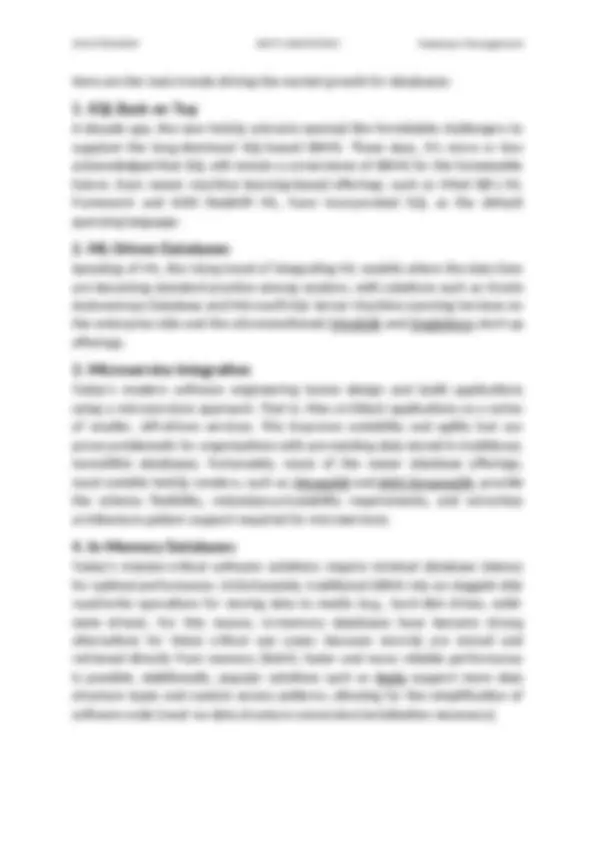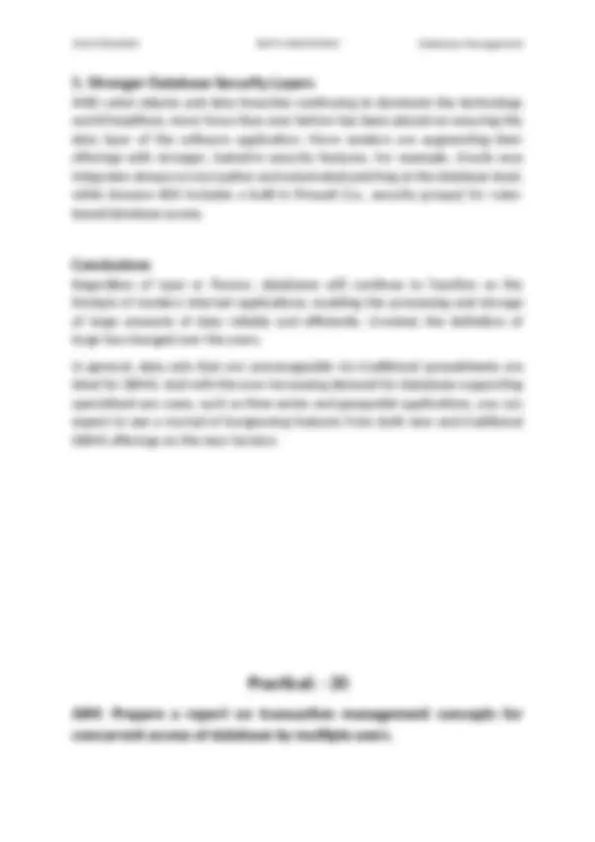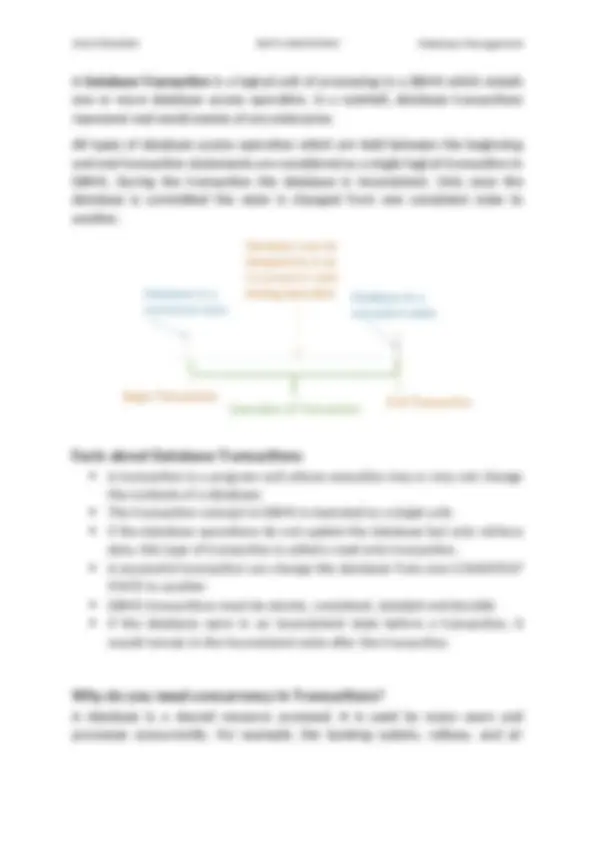







Study with the several resources on Docsity

Earn points by helping other students or get them with a premium plan


Prepare for your exams
Study with the several resources on Docsity

Earn points to download
Earn points by helping other students or get them with a premium plan
Community
Ask the community for help and clear up your study doubts
Discover the best universities in your country according to Docsity users
Free resources
Download our free guides on studying techniques, anxiety management strategies, and thesis advice from Docsity tutors
uploaded dbms practicals for the sake of project
Typology: Exercises
1 / 9

This page cannot be seen from the preview
Don't miss anything!






With more data created in the last couple years than in humankind’s entire history, the need to effectively manage, manipulate, and secure these information assets has never been more critical. This demand has traditionally been addressed by the leading database vendors. However, over the past decade, a myriad of challengers has entered the fray to bring order to chao vis- à-vis the ongoing data explosion.
The amount of data we produce every day is truly mind-boggling. There are 2. quintillion bytes of data created each day at our current pace, but that pace is only accelerating with the growth of the Internet of Things (IoT). Over the last two years alone 90 percent of the data in the world was generated. This is worth re-reading! While it’s almost impossible to wrap your mind around these numbers, I gathered together some of my favourite stats to help illustrate some of the ways we create these colossal amounts of data every single day. Databases have subsequently gone through a dramatic evolution in recent years, with some Flavors going the way of the floppy disk and others thriving to
this day. Veteran DBAs will recall cutting their teeth on early Informix, SQL server, and Oracle DBMS offerings (the latter two are still dominant), while millennial developers reminisce about the open-source simplicity of MySQL/LAMP stack and PostgreSQL. Last but not least, today’s generation of DevOps engineers prefer the unstructured agility of NoSQL databases, like MongoDB and DynamoDB.
As it stands, most databases fall into one of two categories: relational database management systems (RDBMS) and the newer unstructured and/or special application databases. The former has been around since the 1970s and consists of related tables, which in turn are made up of rows and columns. Relational databases are manipulated using the structured query language (SQL), the de-facto standard language for performing create, read, update, delete (CRUD) functions. The RDBMS is the dominant database type for enterprise computing and its SQL language, the lingua franca for communicating with databases. SQL-based RDBMS still make up 60.5% of databases in deployment, according to a recent survey by ScaleGrid.io. In fact, this continued popularity of the SQL language has resulted in big data offerings, like the fittingly named SQL-on-Hadoop and Apache Hive, to adopt the language, just to name a few. The advent of the cloud saw data processing capabilities scale horizontally like never before, just in time to support the skyrocketing production of both structured and unstructured data brought on by the internet. With the latter gaining prominence, some posited that a new database paradigm was in order. Hence, NoSQL was born — a broad category that today includes all databases except those that use SQL as its main language. Because NoSQL databases have no set requirements in terms of schemas or structure, they are ideal for today’s software environments that utilize DevOps toolsets and CI/CD pipelines.
The global market for database management systems (DBMS) is estimated at nearly $63.1 billion for the year 2020 and is projected to reach $125.6 billion by 2026, growing at a CAGR of 12.4% over the period, according to Expert Market Research.
With cyber-attacks and data breaches continuing to dominate the technology world headlines, more focus than ever before has been placed on securing the data layer of the software application. More vendors are augmenting their offerings with stronger, baked-in security features. For example, Oracle now integrates always-on encryption and automated patching at the database level, while Amazon RDS includes a built-in firewall (i.e., security groups) for rules- based database access.
Regardless of type or flavour, databases will continue to function as the linchpin of modern internet applications, enabling the processing and storage of large amounts of data reliably and efficiently. Granted, the definition of large has changed over the years. In general, data sets that are unmanageable via traditional spreadsheets are ideal for DBMS. And with the ever-increasing demand for databases supporting specialized use cases, such as time-series and geospatial applications, you can expect to see a myriad of burgeoning features from both new and traditional DBMS offerings on the near horizon.
A Database Transaction is a logical unit of processing in a DBMS which entails one or more database access operation. In a nutshell, database transactions represent real-world events of any enterprise. All types of database access operation which are held between the beginning and end transaction statements are considered as a single logical transaction in DBMS. During the transaction the database is inconsistent. Only once the database is committed the state is changed from one consistent state to another.
A transaction is a program unit whose execution may or may not change the contents of a database. The transaction concept in DBMS is executed as a single unit. If the database operations do not update the database but only retrieve data, this type of transaction is called a read-only transaction. A successful transaction can change the database from one CONSISTENT STATE to another DBMS transactions must be atomic, consistent, isolated and durable If the database were in an inconsistent state before a transaction, it would remain in the inconsistent state after the transaction.
A database is a shared resource accessed. It is used by many users and processes concurrently. For example, the banking system, railway, and air
ACID Properties are used for maintaining the integrity of database during transaction processing. ACID in DBMS stands for A tomicity, C onsistency, I solation, and D urability. Atomicity: A transaction is a single unit of operation. You either execute it entirely or do not execute it at all. There cannot be partial execution. Consistency: Once the transaction is executed, it should move from one consistent state to another. Isolation: Transaction should be executed in isolation from other transactions (no Locks). During concurrent transaction execution, intermediate transaction results from simultaneously executed transactions should not be made available to each other. (Level 0,1,2,3) Durability: · After successful completion of a transaction, the changes in the database should persist. Even in the case of system failures.
Based on Application areas Non-distributed vs. distributed Compensating transactions Transactions Timing On-line vs. batch Based on Actions Two-step Restricted Action model
Based on Structure Flat or simple transactions: It consists of a sequence of primitive operations executed between a begin and end operations. Nested transactions: A transaction that contains other transactions. Workflow
Transaction management is a logical unit of processing in a DBMS which entails one or more database access operation It is a transaction is a program unit whose execution may or may not change the contents of a database. Not managing concurrent access may create issues like hardware failure and system crashes. Active, Partially Committed, Committed, Failed & Terminate are important transaction states. The full form of ACID Properties in DBMS is Atomicity, Consistency, Isolation, and Durability Three DBMS transaction types are based on Application Areas, Action, & Structure. A Schedule is a process creating a single group of the multiple parallel transactions and executing them one by one. Serializability is the process of search for a concurrent schedule whose output is equal to a serial schedule where transactions are executed one after the other.